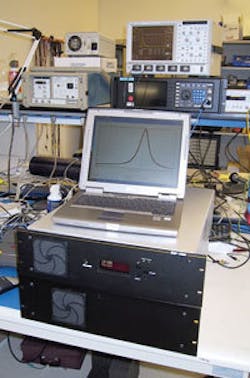SPECTROSCOPY: Post-harvest monitor senses fruit-destroying ethylene

One of the simplest hormones in all of nature is ethylene gas (C2H4). Naturally produced by plants, it affects the ripening of fruits and vegetables and, indeed, has been called the death hormone for its role in pushing fruit toward senescence (putting a bunch of bananas in a plastic bag will hasten its transformation into a pulpy brown mass). While fruit growers can use the gas to aid ripening, they more often aim to limit its concentration to reduce spoilage. For this purpose, researchers at Picarro (Sunnyvale, CA) and Ethylene Controls (Selma, CA) have developed a simple, rugged ethylene monitor based on cavity ring-down spectroscopy (CRDS).1 Given less than five minutes measurement time, the tool can measure ethylene to two parts per billion (ppb) volume.
In the CRDS unit, a 20-mW distributed-feedback diode laser is tuned to match the 1618-nm absorption peaks of ethylene. A pulse from the laser is trapped in a high-finesse optical cavity brought to resonance with a piezoelectrically swept mirror and filled by a continuous flow of the air to be analyzed; the time it takes for the pulse to escape (or, more precisely, the speed of the output’s exponential decay) determines the concentration of ethylene in the air. The ring-down cavity is 210 mm long, holds 25 mL of air for analysis, and has a 32.4‑µs cavity-ring-down time. Temperature and pressure sensors allow precise correction for environmental conditions.
The optics and mounting hardware all fit in a 5 × 10-in. package, which is then thermally and vibrationally isolated from its surroundings within a package that fits into a 3U (5.25-in.-high) rack space (see figure). Other rack-mounted hardware contains the pump and power supply.
The researchers determined by experiment that reducing the air pressure to 120 Torr narrowed the spectral peak considerably while only slightly reducing its height. The researchers also settled on using the 167.6- and 1617.8-nm ethylene lines, as they are not only strong, but are separated from spectral lines of background gases such as water vapor, carbon dioxide, and methane. A polynomial was fitted to the tip of the measured peak to determine its spectral position.
The instrument was tested in the laboratory of Adel Kader at the University of California, Davis’ department of pomology. Four ethylene/air mixes at different concentrations were measured: 7.4 parts per million (ppm), 1.77 ppm, 1.00 ppm, and 75 ppb. The mixtures were measured both by the CRDS system and a reference gas-chromatography system; the difference in readings ranged from 4% at the highest concentration to 12% at the lowest. Because the CRDS approach measures absolute optical loss, the calibration of one CRDS instrument is applicable to all other CRDS systems for the same concentration readings.
Catching the culprit
The CRDS instrument was also tested at a cold-storage room for kiwifruit in Selma, CA. Although the ethylene concentration was expected to be lass than 10 ppb, it read consistently higher; an inventory showed the presence of ethylene-emitting Asian pears in the room. Upon removal of the pears and two days of venting, the ethylene levels dropped to below 10 ppb-safer for the kiwifruit.
The instrument is currently targeted to the research community, notes Kathleen Hartnett, director of business development at Picarro. Once more experience is gained, CRDS may find its way into commercial controlled-environment fruit-storage facilities.
REFERENCE
1. Edward H. Wahl et al., Optics Express 14(4) (Feb. 20, 2006).
About the Author
John Wallace
Senior Technical Editor (1998-2022)
John Wallace was with Laser Focus World for nearly 25 years, retiring in late June 2022. He obtained a bachelor's degree in mechanical engineering and physics at Rutgers University and a master's in optical engineering at the University of Rochester. Before becoming an editor, John worked as an engineer at RCA, Exxon, Eastman Kodak, and GCA Corporation.
